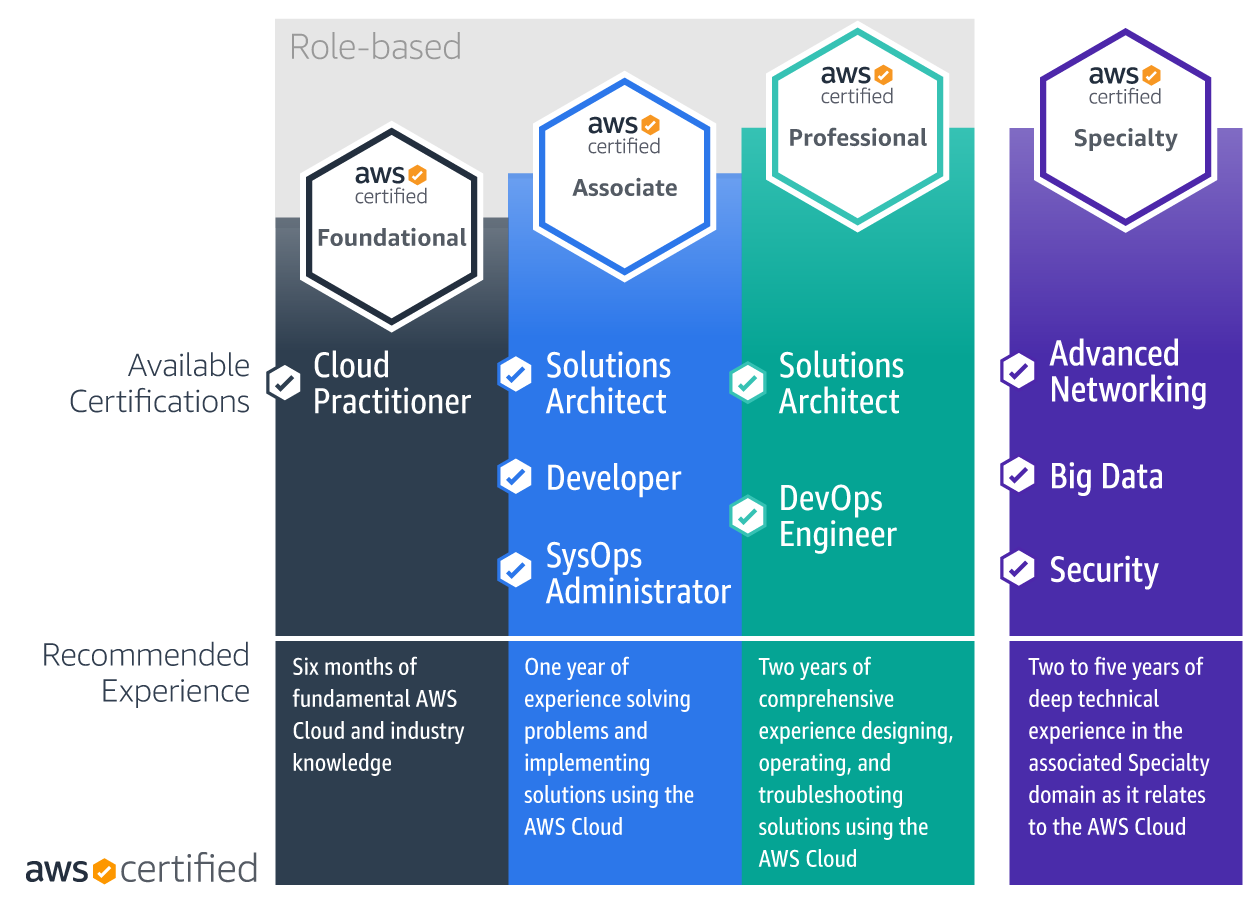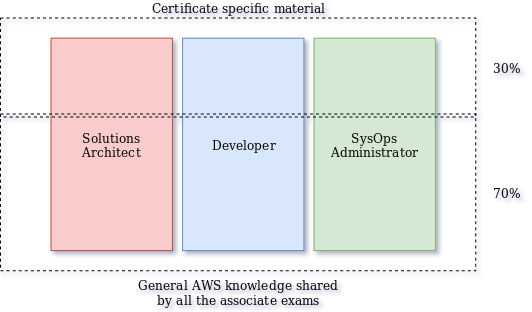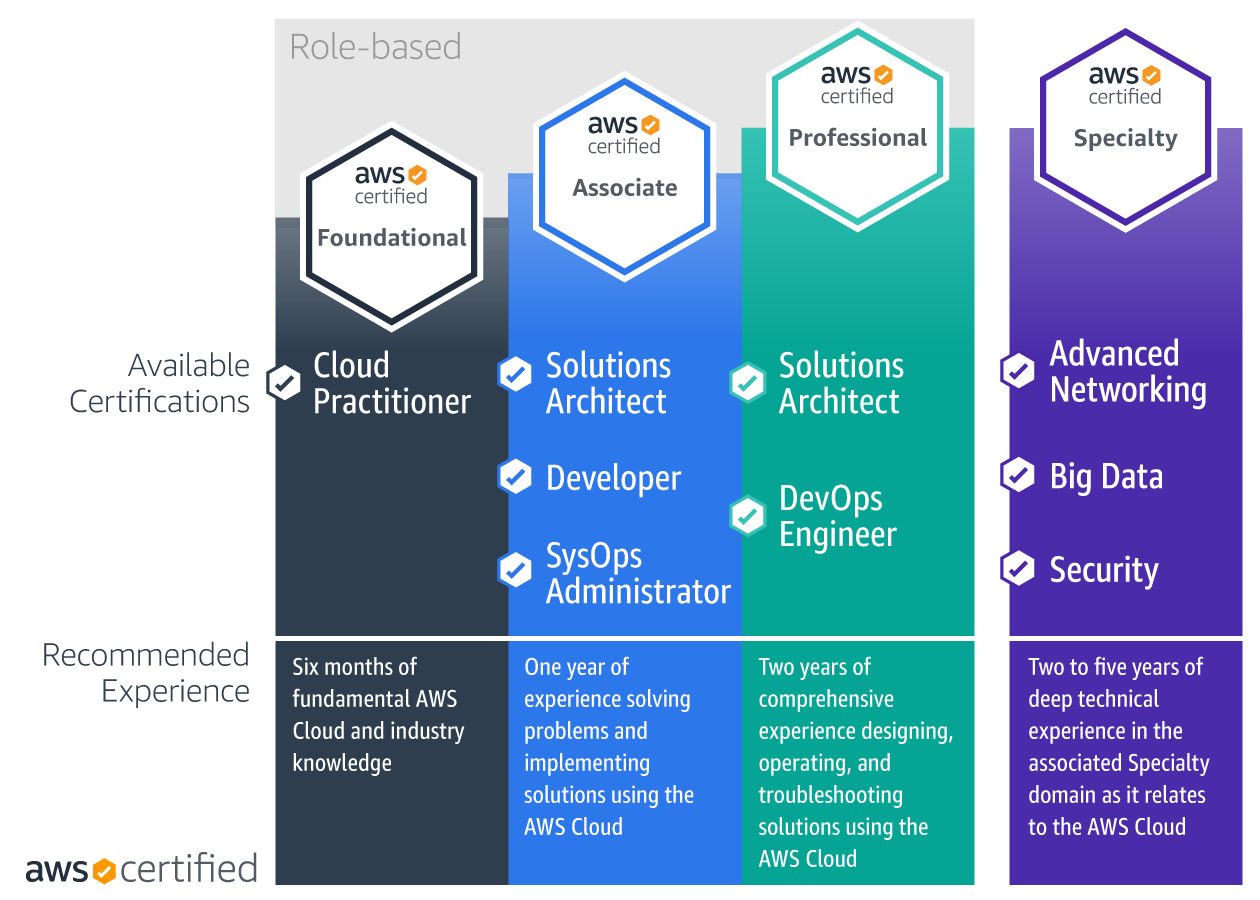My journey to cloud environments started with AWS. First I staggered through the internet trying to find a good guide for understanding cloud computing, different platforms and terms used. I spent considerable time on this (retrospectively) useless wandering until I started studying for the Solutions Architect Associate certification and got my first bite of well-structured course material on my first ever cloud: AWS. Even if some people consider certifications silly and a waste of time, the certification courses themselves are a brilliant way of grasping how a cloud platform works.
My personal opinion on AWS is that it may not be the most user-friendly platform, but it’s still the most versatile one out there. If there is something that you can do in cloud, you can probably do it in AWS. This being the case, I would choose AWS as a running platform unless there is some reason not to.

Picture1: AWS’s chart of all the certificates
Certifications
An up-to-date list of AWS’s certifications can be found here. No new associate or pro level certs have been added during the time I’ve been around the scene, but the existing exams have been slowly updated to match the AWS of 2019. The names of the certifications have stayed the same though. Unlike Azure and GCP where exams are kept up to date, AWS’s exams represent a snapshot of a given time. From the exam taker’s perspective this is a good thing, but from a practical implementation perspective, it’s a bad one. The exam-taker expects the study material to stay constant for years, and as such there are lots of exam material online to aid you. In practice, you end up studying old material and usually the newest Re:Invent stuff is not in the exams. The worst (or best?) example of this is the reserved instance classes (heavy/light utilization) that are obsolete and any official documentation can’t be found about them, but still, I’ve found questions on them on both Solutions Architect Associate & Professional exams. Both of these exams have now been updated, and I doubt there are any reserved instance class related questions, but in a few years, there will be something similar.
Certifications used to be valid for two years, with one year grace period with the option of doing a simple re-certification, even though your cert has expired. Because that system was rather confusing the new exams are now just valid for three years during which they can be extended by doing the re-certification exam. There used to be a requirement on passing a specific associate exam to even have the possibility to try a Pro cert exam, but this restriction was removed late 2018. This doesn’t mean that you should go straight for Pro certifications unless you have worked with the platform for years using a plethora of services.
Associate certifications

Picture2: Associate exams and shared material
Associate certs share around 70% of the same base of ”this is AWS”-material with each other concerning networking, IAM, storage etc. If you do the Solutions Architect Associate certification first (which I recommend) you can do the Developer and SysOps courses with few days of prepping. Should you choose this method? Well, it looks better on your CV but really it brings little extra to the table. The Developer certification material more thoroughly covers parts of the developer centred material such as DynamoDB and SysOps and has some more details on OpsWorks and Elastic Beanstalk. You really only have to study the difference between your first associate exam and the new one you’ll be doing. If you got a sponsor for your exam fees and you want to boost your CV, go for it.
Professional certifications
The pro level exams cover some common ground with each other, both being AWS exams, but they share fewer details when compared to the Associate exams. For me, It took a few months to study for both exams individually. I initially started reading for the DevOps Pro right after I got my associates done, but it was too steep a hill for me to climb, and I ran out of motivation around halfway through the course materials. One year later with actual AWS projects under my belt, I read through the materials which now felt easy and passed the exam quite easily. I tried studying for the Architect Pro after that, but hit that familiar wall once again, fast forwarding to 1 year of AWS projects and told my colleague how ”this course material brings very little new to me” and passed the exam.
For professional certifications I have only one piece of advice:
Do. Actual. Projects. On. Cloud.
After that they are easy.
I think that owners of Pro level certifications are somewhat respected if such a term should appear in your CV but once again I don’t really think there is much difference if you have one or two.
Speciality certifications
Unlike general ones, the specialities share very little with each other, only concentrating on one thing and going deep into it. I have to admit that I haven’t done any of the special certs, only skimmed through their content. I intended to do the Advanced Networking certification, but gave up around half-way through the course material when it was going through BGP’s finest details. As AWS certificates go, they are quite new with new ones coming every now and then, so I don’t know how much reputation you get by passing them.
Study Materials
I totally and wholeheartedly suggest that you use www.acloud.guru for studying. The guys and gals there are doing a fabulous job on online courses. acloud.guru has a practice exam (usually) at the end of their course, which is quite sufficient. You can also buy a practice exam from AWS with some 20 questions, but it’s usually badly written and even if you know your stuff (and pass the actual exam) you might end up with just 60% of the questions correct. If you are feeling cheap and you are gonna do only one certificate, you can grab a acloud.guru course dirt cheap from www.udemy.com; they have a sale going on every day.
In addition to acloud.guru I complimented the materials with those on www.linuxacademy.com on Pro Solutions Architect course, as at that time there were no practice end exam options on acloud.guru and I felt that some of the services were not explained in enough detail.
I read every whitepaper that is suggested in the courses, and I also read FAQs and documentation on the most important services. As noted on the first blog post on this series do the following:
- Read the certification requirements
- Take part in a web course that goes through the relevant material
- Read the documentation for the most important services
- Do some practice exams
- Ace the exam
What I did forget to mention though, is using the service. For every service on the exam, you should use the actual service. If you got a pet project to use them on, great. If you don’t, just click through the dialogues so that you understand every option and how it influences the end result. For Pro certs you also have to do some work with cloud computing, otherwise, the wall is too high for you to climb, sorry.
Doing the exam
You can reserve your exam time on www.aws.training. If English is not your first language, remember to mark so on the portal BEFORE reserving the exam; this gives you some extra time. You can do this on the AWS Training and Certification portal by clicking ”Upcoming events”→”Request Exam Accommodations”→ ”Request Accommodation” → ”ESL +30 MINUTES”.
The options are basically to do a monitored exam where a person watches how you are faring, or use a kiosk. In Finland, the observed options are located in Helsinki and kiosks can be found in Helsinki and Tampere. There has been a lot of conversation about the kiosk PCs booting in the middle of the exams, possibly multiple times, and how they are monitoring if you cover your mouth, thus creating more stress. Personally, I liked the kiosk experience, as I could do the exam on the other side of the road from our office in Tampere. Yes, the passport recognition mechanism was broken, as told by the receptionist, and the person on the other end of the line wouldn’t or couldn’t understand that, requiring me to start exam registration a few times over, but the exam itself went quite smoothly.
Right after the exam, it tells you how did you fare and in a few minutes you get the results also to your email, with percentage grading on different areas of the exam.
Other posts in this series:
Part 1: Introduction to cloud certifications
Part 3: Google Cloud Platform (GCP)
Part 4: Microsoft Azure



